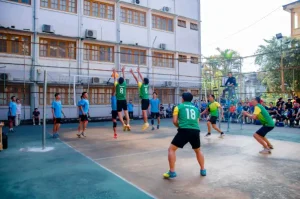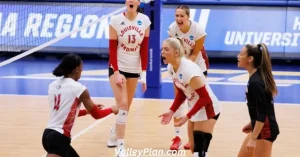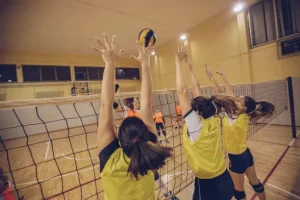In the 5-1 volleyball rotation system, one player is the team’s primary setter, and they rotate to the back row when they’re not in that role. This ensures that there is always a setter available to set the ball for the hitters in the front row.
- The “5” represents the number of attackers or hitters in the front row.
- The “1” illustrates the designated setter in the back row.
The 5-1 system simplifies play-calling and maintains consistency in the setter position.
Role Of Rotation In Volleyball
The sport of volleyball encourages teamwork. Player rotation is an essential game point, where every team member takes specific positions. Rotations ensure fairness, prevent player specialization in particular roles, and add complexity to the sport.
There are also other rotation strategies like 4-2 rotation, 6-2 rotation. But in volleyball, 5 in 1 rotation system is mainly used as a rotation strategy.
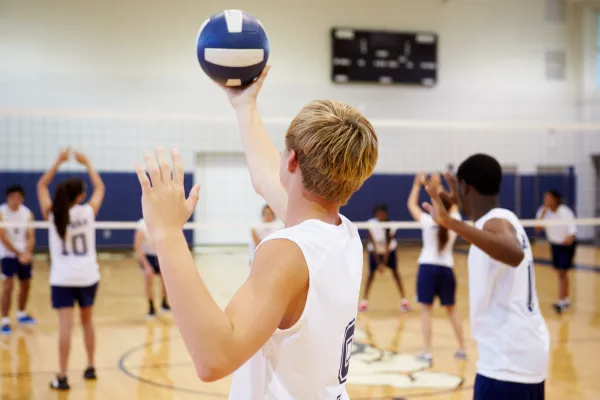
Key Positions In The 5-1 System
To understand the 5-1 rotation better, it’s essential to know the key positions and their roles:
- Setter (Position 1): The setter sets the ball for the attackers. They are often considered the team’s quarterback, as they make important decisions about which hitter to put. The setter spends most of their time in the back row during the 5-1 rotation; they rotate to the front row, but when it’s their turn,
- Outside Hitter (Positions 4 and 5): Refer to the left-side hitter. The outside hitter occupies positions 4 and 5 in the front row.
- Middle Blocker (Positions 2 and 3): The middle blocker, or middle hitter, is positioned in the front row in positions 2 and 3. They are responsible for quick attacks and blocking at the net.
- Opposite Hitter (Position 2): The opposite hitter, the right-side hitter, plays in the front row in position 2. They often provide an additional attacking option and can be effective in blocking as well.
- Libero (Back Row Specialist): The libero is a specialized defensive player who can replace any back-row player without counting as a substitution. They are essential for defense and serve reception.

How The 5-1 Rotation Works
Now that you know the positions, let’s explore how the 5-1 rotation system works during a volleyball match:
- The game starts with the setter in the back row (Position 1). The middle blocker, outside, and opposite hitter are in the front row.
- As the rally progresses and points are won or lost, players rotate positions clockwise. This means that when the team regains the serve from the opponent, each player moves one position clockwise, assuming they still need to be in the correct rotation spot.
- When the setter rotates to the front row (Positions 2 and 3), it becomes an attacking option in addition to the setting. The middle blocker also transitions to the back row.
- The team continues to rotate clockwise throughout the match, ensuring that the setter is always in the back row. This rotation maintains the integrity of the 5-1 system.

Benefits Of The 5-1 Rotation System
The 5-1 rotation system offers several advantages:
| Advantage | Description |
|---|---|
| Consistency | With one primary setter, the team can develop a rhythm and consistent play-calling. This ensures that hitters become familiar with the setter’s style and timing. |
| Versatility | The 5-1 system allows for a versatile offensive strategy. Moreover, with multiple attacking options in the front row, the team can adapt to different situations and opponents. |
| Effective Blocking | The 5-1 system provides strong blocking capabilities; however, middle blockers in the front row play a crucial role. Effective blocking, consequently, is essential for a robust defense. |
| Improved Defense | The libero can focus on improving the team’s defense, as they don’t need to worry about front-row responsibilities. This enhances overall team defense. |
| Simplified Play-Calling | Coaches and players find it easier to develop and implement play-calling in a 5-1 system due to the consistency of the setter position. |

Challenges And Considerations
While the 5-1 rotation system has many advantages, there are also challenges to consider:
| Challenges And Considerations | |
|---|---|
| Setting Quality | The effectiveness of the 5-1 system heavily relies on the setter’s ability to deliver accurate and well-timed sets consistently. Additionally, a strong setter is vital for success. |
| Defensive Strategy | Moreover, coaches must design a solid defensive strategy to accommodate the rotation of players and ensure adequate coverage. |
| Hitter Adaptation | Hitters must adjust to different setters in the front row, as the primary setter is in the back row. Consequently, This adaptability is crucial for success. |
| Skill Levels | The 5-1 system is most effective when the team has skilled hitters and a competent setter. A team with weak hitters may need help to maximize its potential in this rotation. |
| Injury Considerations | Injuries to the primary setter can disrupt the 5-1 system. Consequently, Teams must have backup setters prepared to step in if needed. |

Tips For Success In The 5-1 Rotation
To excel in the 5-1 rotation system, consider the following tips:
| Tip | Description |
|---|---|
| Setter Development | Invest time in developing your setter’s skills. A strong setter is the cornerstone of the 5-1 system. |
| Hitter Adaptation | Encourage your hitters to adapt to different setters. Additionally, practice with various setters to enhance their versatility. |
| Solid Defense | Work on your team’s defensive strategies to cover the court effectively during rotations. |
| Effective Blocking | Develop a solid blocking game, especially when your middle blockers are in the front row. |
| Communication | Effective communication is critical. Keep your team informed about rotations and play-calling. |
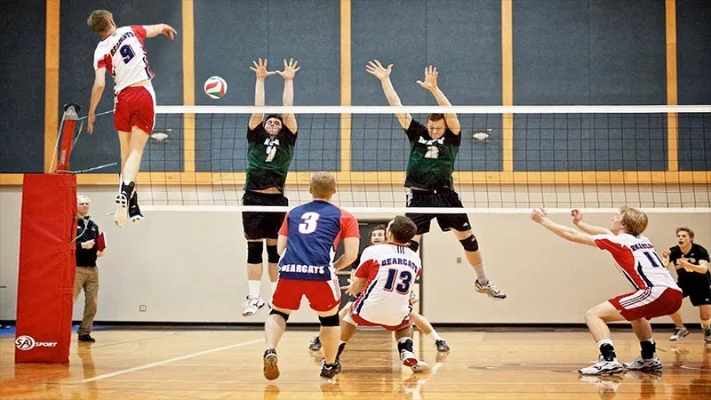
FAQs
The two most common offensive systems in volleyball are the 5-1 system, which uses five hitters and one setter for all six rotations, and the 6-2 system, which uses a total of six hitters and two different setters, depending on where they are in the rotation.
The 4-2 formation is often used if the team does not have strong hitter and is common at a lower level of play. In this formation, there are four hitters and two setters. In order to always have a setter in either row, setters will position themselves opposite each other in the rotation.
There are a few different rotational systems a volleyball team can run; one is the 6-2. The first number, six, represents the number of hitters on the court and the second number, two, stands for the number of setters. Usually, there will be three front-row hitters and a back-row setter.
A kill is awarded to a player any time an attack is unreturnable by the opposition and is a direct cause of the opponent not returning the ball, or any time the attack leads directly to a blocking error by the opposition. A kill leads directly to a point.
Conclusion
The 5-1 volleyball rotation system is a dynamic and versatile strategy; therefore, it requires precision and teamwork. Additionally, you must understand the responsibilities for success on the court.
Mastering the 5-1 rotation involves, first and foremost, consistent practice. Additionally, strong player development is crucial in honing the necessary skills. Furthermore, effective communication plays a pivotal role in the successful execution of the rotation.
In conclusion, the 5-1 rotation is not just a good strategy; it is an essential technique that you should master to become a proficient player.
Related Posts
What is a Double Hit in Volleyball?
How To Get Better At Volleyball

Hassan Baig a former volleyball player, coach and Administrative At Volleyplan.com.
My name is Hassan Baig and I am a former volleyball player and coach. I have a passion for the sport and have dedicated my life to promoting it. I have worked with some of the best players in the game and have helped them achieve their full potential Read More



